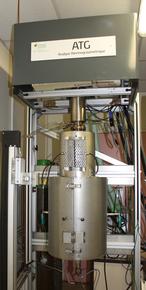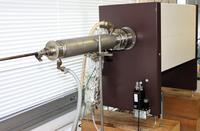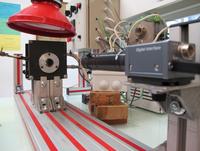Lab-scale reactors
Last update: 8 March 2023
Thermogravimetric analyser
The thermogravimetric analyser is used for fine kinetic studies of physico-chemical transformations such as pyrolysis, oxidation, gasification, evaporation, etc.
The advantage of our device is to be able to work with a large mass of samples (up to 80 mg), under pressure (up to 80 bar) and in the presence of steam (0-0,5 atm.).
Pyrolab
This reactor is used to estimate the behaviour of every type of biomass, under well controlled pyrolysis conditions. It consists of an electrically heated (from 400 to 700°C) horizontal tubular reactor into which is introduced a vessel with a capacity of 1 to 10 g of biomass. Thanks to a precise system used to collect solid, liquid and gaseous products, mass balances over 95% m/m are obtained. For example, this device is used to estimate how catalysts soaked in biomass affect the yields and compositions of pyrolysis products.
AliGaTor
This reactor is used to study biomass torrefaction or pyrolysis, and to characterize the reactional mechanisms involved in the thermal and catalytic reduction of tars during cracking or reforming reactions under fluidized bed conditions.
The reactor consists of two concentric quartz tubes introduced into a vertical electric oven enabling temperatures of up to 1000°C to be reached. The connection between the two tubes is made airtight by a set of flanges. The outer tube, which is 36 mm in diameter, is closed at the end; a bed of solid reactant (biomass, catalyst, coal) is deposited on a sintered section fixed inside the inner tube, which is 30 mm in diameter. The reactive gas can be supplied from bottles of standard gas (inert or reactive gas), or from a specific device allowing tar injection. The operating conditions ensure that no preferential passage is formed within the bed and ensures uniform heat treatment. This gaseous atmosphere is introduced into the annular space, is heated by convection in contact with the surfaces of the tubes, and then crosses the reactive bed. After reaction, the gases produced are removed via the exhaust of the inner tube, analysed in a semi-continuous way by gas chromatography (GC), and finally cooled in a heat exchanger immersed in a cryogenic bath.
The condensable species are collected in the heat exchanger; the incondensable gases are analysed on-line by Micro-GC.
Eva
This device is used to study the mechanisms involved in the evaporation of liquid fuel droplets so as to analyse and model the kinetics, the quantity of residues and the reactions of polymerization / condensation that take place during combustion.
For more information, see the video aside.
Last update: 8 March 2023


